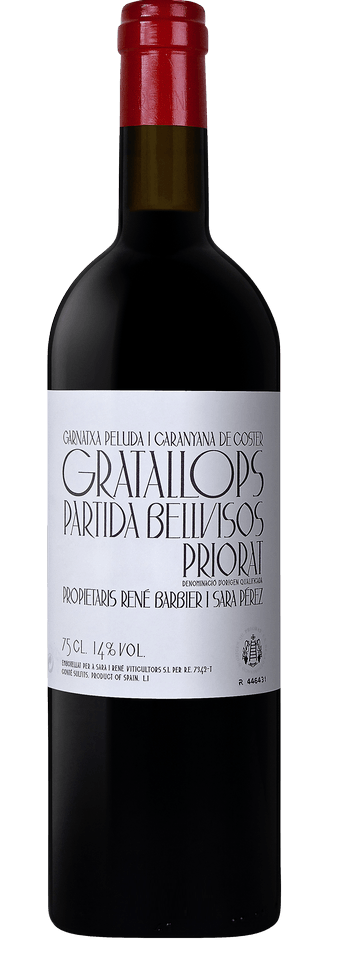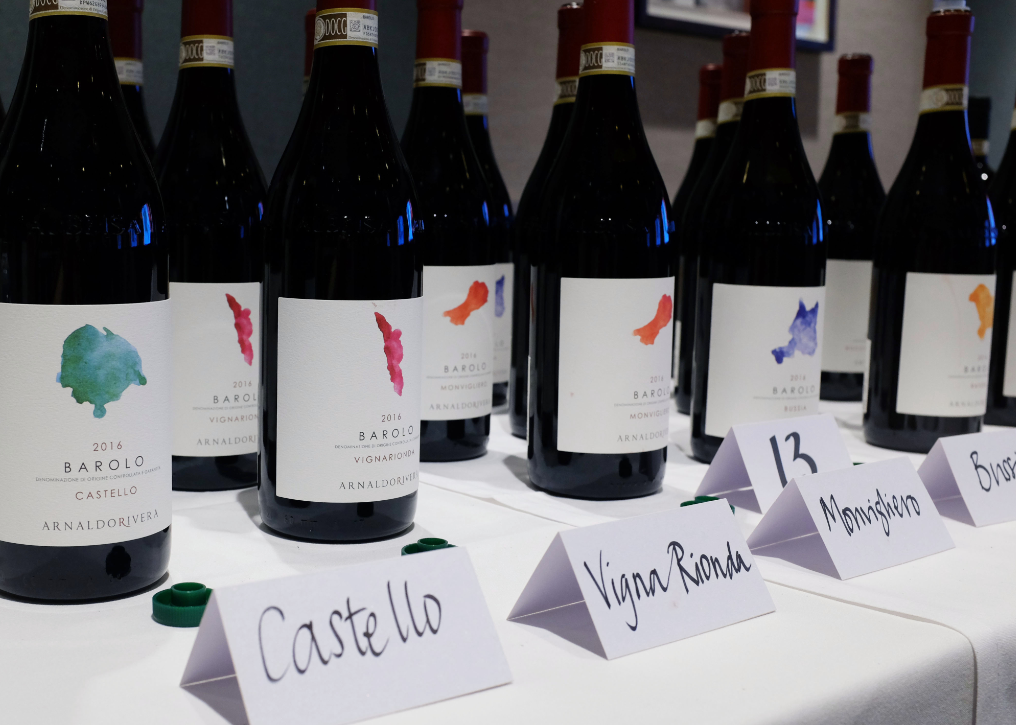2015 Priorat, Partida Bellvisos
'A small production gem from north-eastern Spain'
£245 per 6 bottle case in bond
I am just back from a fascinating week visiting numerous estates in the often-overlooked region of Priorat in north-eastern Spain. I was keen to learn more about the region and specific estates with whom we have worked previously. My conclusion is simple: there are a great many easier places to produce wine than on the steep slopes and rocky, schistous soils of Priorat, where the vines must contend with the heat and relatively low rainfall. That said, there is something incredibly individual about the resultant wines, and, you’ll be pleased to hear, I uncovered a few gems.
The 2015 Priorat from Partida Bellvisos is one such wine. It is produced by René Barbier (the fourth generation of his family to have that name!) and his partner Sara Perez. René’s family own Clos Mogador, regarded among the finest Priorat estates, and Sara Perez’s family own another great name in the region, Mas Martinet. Together, they started this new project in 2001, when they purchased a small vineyard called El Bellvisos (Bella Vista – beautiful view). This remarkably steep, sloping vineyard had been neglected for over 40 years, yet it was well-situated and offered significant potential. As the couple comment, ‘there are no neighbours due to the steep slopes surrounding it: not even the most valiant would plant a vineyard here!’. Having now spent some time in the vineyards of Priorat, I can vouch for that comment – I simply shook my head in amazement when told how growers cleared and replanted vineyards in that heat and on those soils, vineyards that had previously been reclaimed by nature.
René and Sara’s aim has always been to produce a wine that was at one with nature, and the Bellvisos vineyard, which had not witnessed any chemical usage for such a long period, provided just the opportunity. From the outset, both René and Sara have sought to produce wines from organically grown fruit with as little intervention as possible. This is an admirable approach and can at times prove very challenging, but, from the few lines above, you no doubt get the impression that these two will not shirk a challenge! The difficulty with this plot was that the soil had not been broken up to make new terraces; it took a lot of effort to address soil erosion, low biodiversity and loss of soil structure. Most of this was addressed by hand ploughing or using a mule, as well as embracing aspects of biodynaminc viticulture.
A word on Priorat
To anyone new to Priorat, it is a region rich in history situated in the province of Taragona. It offers a range of different microclimates and soil structures on account of its steep, sloping vineyards that range from 100 to 700 metres in altitude. Many of its vineyards are craggy escarpments or terraced vineyards in separate mountain valleys. The name ‘Priorato’ means priory and legend has it that a shepherd boy awoke to see angels descending from a celestial ladder. He told a priest about his vision and in 1163 an order of Carthusian monks founded the ‘Priorato de Scala Dei’, literally the ‘Priory of the Stairway to God’. Modern day Priorat incorporates 11 different small villages, of which Gratallops is one of the more famous, and extends a touch over 2,000 hectares. The wines of the region gain their distinctive character on account of the topography and the schistous soils that dominate; schist is well-suited to vines (think of the famous Port vineyards of the Douro). The vine is forced to work hard to sink its roots deep into the fissures that form in the rock, accessing rainwater stored underground to see the vines through a hot Mediterranean summer. The most famous soils of the region are called 'llicorella', where you find alternating layers of slate and quartzite making an almost stripy pattern, just as found in Bellvisos vineyard. Yields are naturally low in Priorat on account of the heat and lack of water, making for intense wines, yet with a mineral backbone and the best do not lack for freshness.
Back to Partida Bellvisos
The Bellvisos vineyard is planted largely with Garnatxa (Grenache) and Cariñena (Carignan). Cariñena brings brighter, more vibrant red fruits to the deeper, juicier fruits of Garnatxa – lending a little more complexity, structure and alleviating the natural alcoholic strength of Garnatxa in the blend. When I met René a couple of weeks ago at Clos Mogador, he told me how much they value ageing, not just in barrel but in bottle too; nothing here is hurried and therefore the 2015 is the current release. René and Sara only make 5,000 bottles of their Priorat wines under the ‘Sara I René Viticultors’ label, but you can tell it is an exciting project for them. I have been stunned by the quality of the red and rosé, Partida Pedrer, which we offered last year. The new vintage is on its way to us as I type.
I include my note below, as well as Luis Gutiérrez’s from The Wine Advocate. It suffices to say I am really pleased to have access to these limited production wines and there is so much I admire in Sara and René approach. The wines are outstanding.

2015 Priorat, Partida Bellvisos, Gratallops Vi de Vila, Sara I René Viticultors
£245 per 6 bottle case in bond
For a naturally bold wine, the 2015 Bellvisos is beautifully balanced, offering deep, dusky berry fruit characters on the nose, like macerated summer berries with a lifted, floral accent. What surprises is the mellow, mature nature of the fruit on the palate, for all its intensity, this is not a heady wine, instead, the clever use of whole clusters has lent a brightness and poise and the blend of equal parts of Cariñena and Garnatxa ensures the bolder Garnatxa is offset. Layered, with that lively mineral character that seems common to the best Priorat, this 2015 is packed with spice-laced loganberry and raspberry with notes of liquorice too. This is unashamedly Mediterranean in style, but the ageing has rounded out the edges and made for a very complete showing. The tannins are silky and fine, beautifully integrated, and the persistent, lingering fruit signals an impressive Priorat that could be broached now or aged for 10 years further. Drink 2022-2032 (SL).
96 points, Luis Gutiérrez, The Wine Advocate
The red 2015 Gratallops Vi de Vila Partida Bellvisos was produced with Garnacha and Cariñena grapes from a 65-year-old vineyard they have been recovering since 2002 after it was abandoned for 30 years. It fermented with some full clusters in open-top vats and 30 days of maceration with the skins and then matured in 2,000-liter Austrian oak foudre for 14 months. It's a powerful and full-bodied Priorat red with 15% alcohol. This is quite Garnacha even if it's approximately a 50/50 blend of the two grapes. It feels very classical, more developed, nuanced and somewhat polished, transporting me to some of the wines from the early 2000s. It has rich and ripe flavors, polished tannins and an earthy minerality that is a texture rather than a flavor. It's still serious and balanced and has the ingredients to develop nicely in bottle. 1,003 bottles and 500 magnums were filled in December 2016. Forty percent of the total volume is bottled in magnum and sold with at least 10 years in bottle. Drink 2020-2030.
One word on ageing (well maybe two!) – many UK drinkers assume all full-bodied Spanish reds need a long snooze in a cool cellar. That isn’t always the case – many modern day Priorat (not that this comment is exclusive to Priorat) can be consumed in the first five to seven years of their life, and there aren’t many that I would be tempted to age for 15 years or more. The winemaking style has a huge influence, but many Priorat producers are favouring a more elegant interpretation than in the past. The varieties are also of importance in determining potential for ageing. Garnatxa isn’t particularly high in tannin nor acidity, but shows a generous, fleshy fruit in youth. Cariñena possesses fine red fruits and is, again, not particularly high in tannin, but it does impart useful acidity. My advice is to broach a Priorat on the relatively young side and see what your palate prefers. I tasted numerous wines on my recent trip from vintages in the last decade, and all were drinking well, even those from 2016/2017.
Please let us know of your interest.
All the best,
Simon



